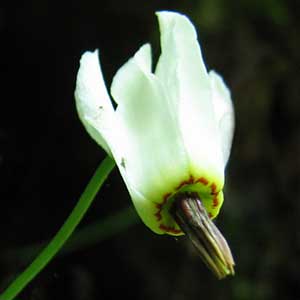Dodecatheon dentatum
Dodecatheon poeticum
dentate shooting star, tooth American cowslip, white shooting star
narcissus shooting star, poet's shooting star
not obvious at anthesis, or sometimes erect to slightly horizontal, slender;
roots white or reddish;
bulblets absent.
not obvious at anthesis;
roots white;
bulblets usually present.
(3.5–)8–20(–30) × (1–)2.5–6(–7) cm;
petiole slightly winged;
blade ovate, base decurrent onto stem, abruptly tapering to petiole, margins subentire to sinuate or crenate, surfaces glabrous.
(3–)5–16(–20) × 0.5–2.5(–3) cm;
petiole usually winged;
blade oblanceolate to spatulate, base usually decurrent onto stem, gradually tapering to petiole, margins usually entire, sometimes denticulate to slightly toothed, surfaces glandular-pubescent.
(1–)2–5(–11)-flowered;
bracts lanceolate, 1.5–5(–8) mm, glabrous.
2–10(–17)-flowered;
bracts narrowly to broadly lanceolate, 2–10 mm, glandular-pubescent.
0.8–5 cm, glabrous.
1–3.5 cm, glandular-pubescent.
calyx light green, 4–6 mm, glabrous, tube 2–3.5 mm, lobes 5, 1.5–3(–4) mm;
corolla tube yellow with red, thin, wavy ring, lobes 5, white, 7–18(–20) mm;
filaments distinct, maroon to black, 0.1–0.5 mm;
anthers (4.5–)5–7.5 mm;
pollen sacs maroon to black, connective dark purple to maroon, smooth;
stigma not enlarged compared to style.
calyx greenish, often with pinkish purple to purple speckles, 5–9 mm, glabrous or slightly glandular at least along margins, tube 2–4(–5) mm, lobes 5, 3–5 mm;
corolla tube maroon and yellow with reddish, thin, wavy ring, lobes 5, magenta to lavender, (8–)10–15(–18) mm;
filaments connate, tube maroon, 1.5–3 × 2–3 mm;
anthers 4–7 mm;
pollen sacs maroon to black, connective deep purple to black, transversely rugose (sometimes seemingly smooth [when immature] or transversely wrinkled [when dried]);
stigma not enlarged compared to style.
pale greenish to tannish, dark yellow apically, valvate, narrowly ovoid, (6–)8–11 × 3–5 mm, glabrous;
walls thin, pliable.
tan, often faintly reddish apically, valvate, short-ovoid, 6–9 × 4–7 mm, glandular-pubescent;
walls usually thick and firm.
without membrane along edges.
without membrane along edges.
= 44.
= 44, 88.
Dodecatheon dentatum
Dodecatheon poeticum
Dodecatheon dentatum occurs mainly on the eastern slope of the Cascade Range from south-central British Columbia to central Washington, with disjunct populations near the Columbia River in southwestern Washington, the Columbia River Gorge, northeastern Oregon, and northern Idaho. In Idaho, this species occasionally forms hybrids with D. pulchellum var. pulchellum (Oberle 262, MO).
(Discussion copyrighted by Flora of North America; reprinted with permission.)
Dodecatheon poeticum grows mainly in the Columbia River gorge and on the eastern edge of the Cascade Range in Washington, and in Oregon. Nearby one can find D. conjugens var. conjugens and D. pulchellum var. cusickii, features of which (the rugose connective of the former, the glandular condition of the latter) are combined in D. poeticum. The distinct filaments of var. conjugens readily distinguish that taxon from D. poeticum; distinction between D. poeticum and D. pulchellum var. cusickii is difficult. The former has maroon pollen sacs; var. cusickii has yellow ones. Plants with all of the features of D. poeticum rarely have the smooth connective typical of D. pulchellum. H. J. Thompson (1953) suggested that D. poeticum (a tetraploid) might be the product of an allopolyploid involving var. cusickii and D. hendersonii (both diploids).
The leaves of Dodecatheon poeticum are occasionally slightly toothed and relatively broad (e.g., K. L. Chambers 2080, OSC) and resemble the leaves of D. dentatum, a species that flowers in the Gorge typically after D. poeticum. Rootstocks with bulblets are rarely seen on herbarium specimens.
(Discussion copyrighted by Flora of North America; reprinted with permission.)


